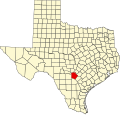Otto Bombach House | |
 | |
| Location | 231 South Alamo Street Bexar County, Texas |
|---|---|
| Coordinates | 29°25′17″N98°29′18″W / 29.42139°N 98.48833°W |
| Part of | La Villita Historic District (ID72001350) |
| Designated CP | January 20, 1972 |
The Otto Bombach House is a contributing structure in the La Villita Historic District of the Bexar County city of San Antonio in the U.S. state of Texas. [1] The one-and-two-story native limestone structure was built by German immigrant Bombach in the mid-19th century. It was acquired and restored by the San Antonio Conservation Society (SACS), which still owns the property. [2] Over the decades, SACS has leased the property to a variety of tenants, including the San Antonio Press Club. Currently, the building houses the Little Rhein Steak House. [3]


